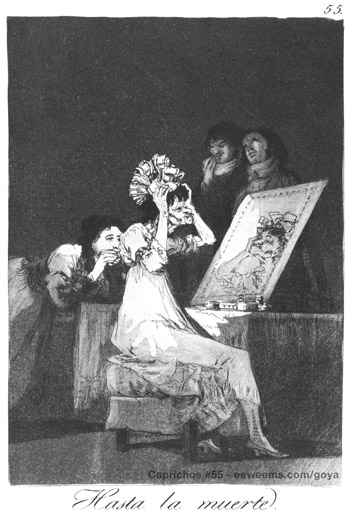Text
caption from the "Prado"
etching version:
"She is quite right to fix herself to look pretty. It is her seventy-fifth birthday, and her girl friends are coming to see her."
"Hace muy bien de ponerse guapa. Son sus dias; cimple 75 anos, y bendran las amigitas a verla."
CAPRICHOS 55
Goya used both the subjects of vanity of the elderly and the reflective powers of mirrors as a running theme through several pieces. Perhaps the most well known is his painting Las Vierjas (also called Que Tal? and simply Time). Fred Licht (among others) has pointed out the similarity of the flat rectangular mirror to the flat rectangular canvas, and how close the two are in function in certain pieces, especially Goya's The Family of King Carlos IV, where Goya seems to indicate that the viewer is in the position of a mirror upon which the subjects gaze, i.e., the painting is the mirrored reflection, not the actual setting (which, incidentally, includes Goya himself, much the way that the earlier great Spanish painter Velasquez had included himself into his painting Las Meninas).
Here in Caprichos 55, the subject is blind to both the actual state of her physical decay and the less than adoring attitudes of the male sycophants of which she is surrounded. The title indicates that no amount of visual evidence will deter the subject from the pursuit of her self-delusion. It has been suggested that the "real" subject of this image is the Dowager Duchess of Osuna, or even Queen María Luisa. However, the theme is such that it transcends any specific person as the caricature subject, and is both a comic mocking of, and a warning of, human hubris.
For further reading, see Goya and Mirrors.

